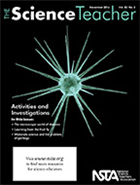Science 2.0: When Students Become Digital Citizens
By sstuckey
Posted on 2016-11-10
Modern science learning requires the use of digital tools and a shift in teaching philosophy and pedagogy. The backbone to this shift rests in a skill that we’ve not yet addressed: digital citizenship.
Last month, we wrote about the International Society for Technology in Education’s (ISTE) Empowered Learner standard (www.iste.org/standards). This month, we discuss the Digital Citizen standard where “students (will) recognize the rights, responsibilities, and opportunities of living, learning, and working in an interconnected digital world, and they act and model in ways that are safe, legal, and ethical.” While this might seem like a lofty goal, we can make sure that students fulfill the requirements of this standard by meeting its four performance indicators, which require students to:
- “cultivate and manage their digital identity and reputation and are aware of the permanence of their actions in the digital world”;
- “manage their personal data to maintain digital privacy and security and are aware of data-collection technology used to track their navigation online”;
- “engage in positive, safe, legal, and ethical behavior when using technology, including social interactions online or when using networked devices”; and
- “demonstrate an understanding of and respect for the rights and obligations of using and sharing intellectual property” (ISTE 2016) (italics added).
As science teachers we must remember that our students’ digital footprints, or “digital exhaust,” referring to data collected on their travels across the digital landscape, will exist long after they leave the classroom. We refer to this as permanence.
To safeguard students’ digital privacy and personal data, it is important to read the Privacy and Terms of Use conditions for websites on which they compose and post content. Teachers should be aware of privacy laws such as the Children’s Online Privacy Protection Act and the Family Education Right to Privacy Act, which we discussed in an earlier column (Smith and Mader 2014). Students must understand how to change the privacy settings on their profiles to prevent others from accessing their content. Even with the most robust security settings, however, content can still leak out into the public area of the digital world. Thus, they should be continually reminded of the importance of reviewing their own content.
Next, teachers can engage students in activities that promote positive, safe, legal, and ethical online behavior. The activities can occur before, during, and after formal instruction.
Before instruction, teachers can use word clouds, graphic organizers, and podcasts to allow students to share what they want to learn from a unit’s explorations. During instruction, students can moderate each other’s discussions and provide feedback using the social platform Todays
Meet (www.todaysmeet.com). This is an excellent way to talk with students about constructive criticism and the appropriateness of their conversations. After the science lesson, students can engage in deeper discussions about their content mastery through discussion boards such as Schoology or Canvas or by critiquing other students’ work with tools such as Padlet or VoiceThread.
A long-standing tradition in our classrooms is the concept of UCC (user-created content)—the idea that students should create their own artifacts, digital content, and media, instead of resorting to Google. UCC gives them an understanding of using and sharing intellectual property. In this type of classroom culture, students create their own media for their products and ask permission, or even “pay” using points, to use another’s work in the class.
Conclusion
Science teachers must create a classroom culture that prepares students for a world of transparency and permanence. The skills that students develop through the Digital Citizen standard will benefit their lives far beyond the classroom walls.
Ben Smith (ben@edtechinnovators.com) is an educational technology program specialist, and Jared Mader (jared@edtechinnovators.com) is the director of educational technology, for the Lincoln Intermediate Unit in New Oxford, Pennsylvania. They conduct teacher workshops on technology in the classroom nationwide.
References
International Society for Technology in Education (ISTE). 2016. The 2016 ISTE standards for students. Arlington, VA: ISTE. www.iste.org/standards/standards/for-students-2016
Smith, B., and J. Mader. 2014. Science 2.0: Protecting students’ online privacy—by law. The Science Teacher 81 (9): 8. http://bit.ly/2crq9XP
This article was originally published in the November 2016 issue of The Science Teacher journal from the National Science Teachers Association (NSTA).
Get Involved With NSTA!
Join NSTA today and receive The Science Teacher,
the peer-reviewed journal just for high school teachers; to write for the journal, see our Author Guidelines, Call for Papers, and annotated sample manuscript; connect on the high school level science teaching list (members can sign up on the list server); or consider joining your peers at future NSTA conferences.
The mission of NSTA is to promote excellence and innovation in science teaching and learning for all. Learn more about the Next Generation Science Standards at the NGSS@NSTA Hub.
Disclaimer: The views expressed in this blog post are those of the author(s) and do not necessarily reflect the official position of the National Science Teaching Association (NSTA).



